
a web page by Don Roberson |
A RE-ENACTMENT: Phase Three of the Battle of Mansfield, 8 Apr 1864 re-enacted 27 Apr 2014 on the Mansfield battlefield |
| Having planned a birding trip to east Texas in late April 2014, I knew we would miss re-enactments scheduled for Pleasant Hill on 4-6 April. Quite unbeknownst to us, the Mansfield re-enactments were scheduled for 26-27 April 2014. Purely by accident we came upon the Sunday event at Mansfield State Historic Site at mid-day, just in time to witness a southern memorial for Brig. Gen. Alfred Mouton, killed early in the Mansfield battle. One re-enactor told me that he represented the 31st Texas cavalry; they would have been dismounted for the Mansfield battle. His unit fired memorial volleys (below left). The Texans would have been part of Brig. Gen. Prince C.J. de Polignac's ("the Lafayette of the South") brigade in Mouton's division. The large monument (below right) is the combined Mouton/Polignac monument [Polignac, "Gen. Pole-Cat" (some southern troops could not pronounce the French name), took command of Mouton's division after his death.] | ||||||||||||
|
||||||||||||
The park's historian moved up and down the line, explaining that we would be watching "phase three" of the Mansfield battle of 8 April 1964, which actually occurred 3 miles south at Chatman's (Chapman's) Bayou. Confederates called the spot "Chatman's (Chapman's ... there is a dispute about the actual name) Orchard" or "Chapman's Bayou," while Union soldiers called the spot "Pleasant Grove." An overview of the entire battle, and maps of phase one and phase three are Civil War Trust's site. So, with this preface, on to the re-enactment of "phase three" of the Battle of Mansfield: |
||||||||||||
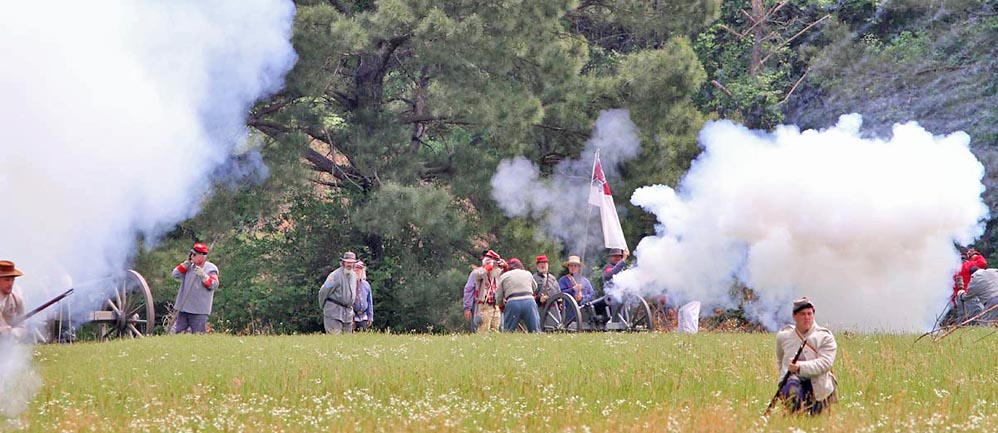 |
||||||||||||
The
Confederates, having crossed Chapman's Bayou, begin the battle with a
thunderous artillery barrage. Union artillery, atop the sloping hill to
the east, return the fire (below). [Note — historically, an artillery
duel did precede Mouton's attack in phase one of the Battle of
Mansfield. Artillery were not involved in phase three. We may best
think of this cannonade as a prequel ... setting the tone. It was
certainly very loud and thrilling.] |
||||||||||||
 |
||||||||||||
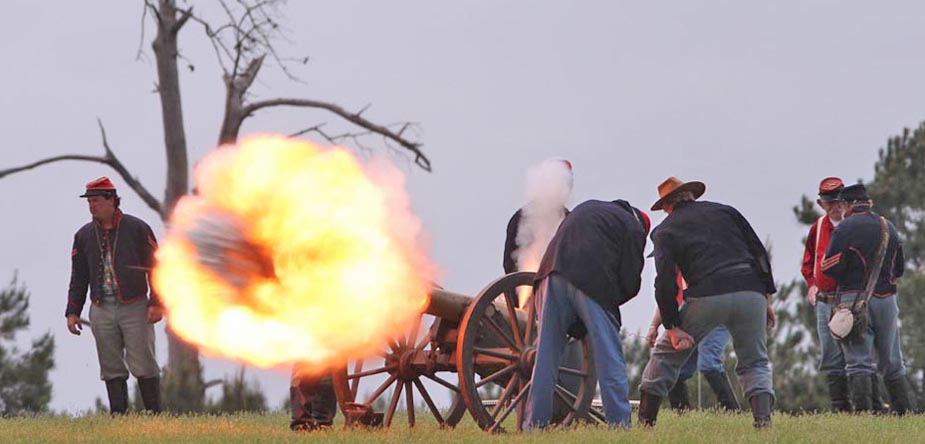 |
||||||||||||
As the smoke from the cannonade clears, rebel forces march towards the Union position (right), often stopping (below) to fire a volley. |
||||||||||||
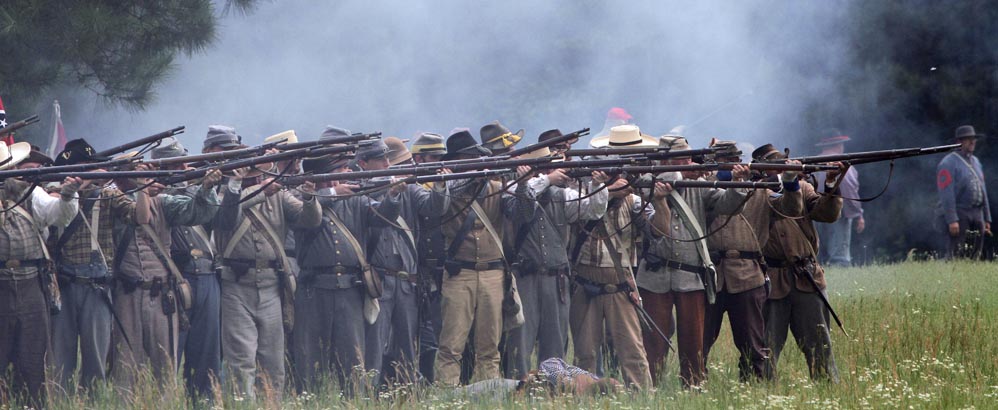 |
||||||||||||
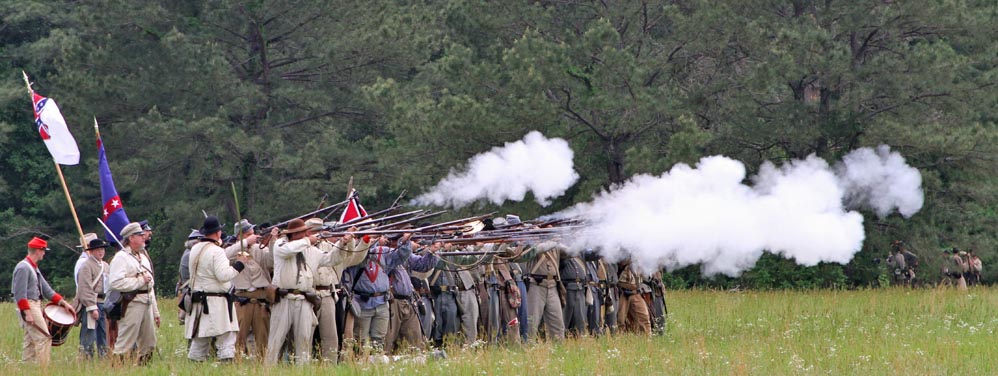 |
||||||||||||
As the movement progresses towards the Union position, on-lookers follow more individual forays, including the small engagements of cavalry or, perhaps, the story of a Confederate teenager who is a lone sharpshooter (see him just below).
|
||||||||||||
Despite orders from this commanding officer, the sharpshooter moves too far forward towards the Union left flank, and is eventually shot by a Northern cavalryman (right). |
||||||||||||
| Meanwhile, the Confederate attack is reaching its apex. As described by Brooksher's (1998) War along the Bayous: the Red River Campaign in Louisiana: "Ahead of them, [Brig. Gen. William H. Emory, of Franklin's First Division,] was preparing a reception. Near the bottom of Chatman's Hill, leading to Chatman (Chapman) Bayou, in an orchard known as Pleasant Grove, the Union commander found his spot. Here he formed a line with Col. Lewis Benedict's 3rd Brigade on the left . . . [On the far left was] the 165th New York... The 30th Maine was held in reserve behind Benedict's portion of the line. The division strength totaled about 5,100. Officers along the Union line quietly told their troops, 'Steady, men, wait until they are almost upon us.' The grim bluecoats did so, holding their fire until the yelling Confederates were virtually on top of them, then blasted their advance apart." | ||||||||||||
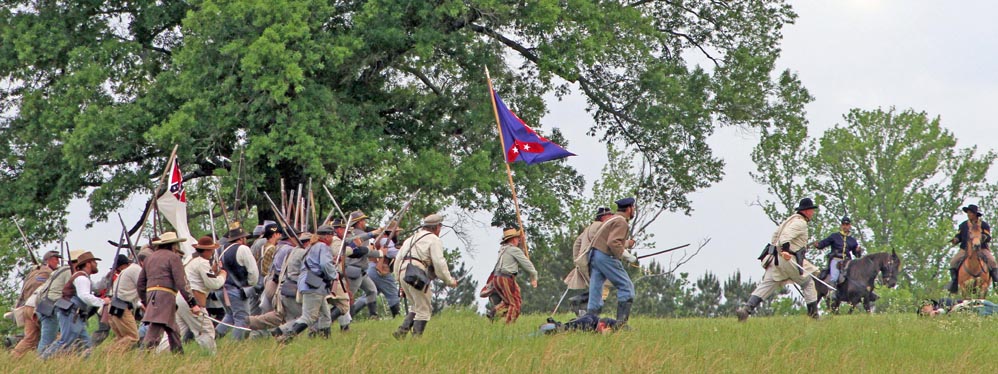 |
||||||||||||
Among those firing at the extreme left end of the Union line are the 30th Maine, moved up from reserve to fill the gap between the 173rd and 165th New York. |
||||||||||||
 |
||||||||||||
The 165th Zouaves then refused the line, turning perpendicular to the main line, and forming at right angles from it, thus protecting the flank. |
||||||||||||
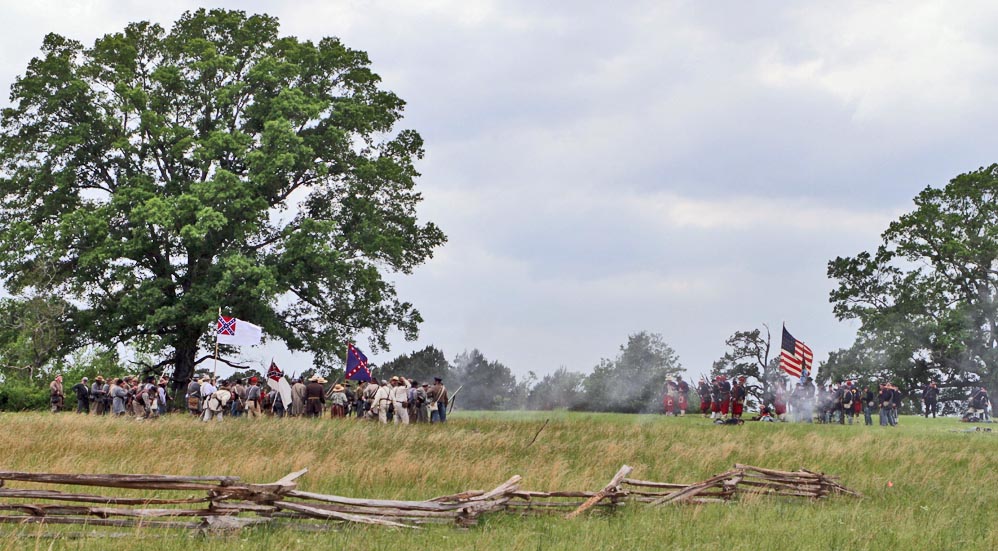 |
||||||||||||
 |
||||||||||||
A Confederate office said, 'Never shall I forget that moment. The very air seemed dark, and hot with balls, and on every side was heard their dull, crushing sound, as they struck the swaying mass, tearing through flesh and bone and sinew. The position of our line could have been traced by our fallen dead." |
||||||||||||
 |
||||||||||||
"With almost reckless courage, Banks rode through the fight, telling his troops, 'My brave men of the Nineteenth Corps, stand your ground, and we shall win the day.'
The Union's last-ditch line had held. Emory's division, including the Zouaves of the 165th New York (below), had stopped the rebel onslaught. |
||||||||||||
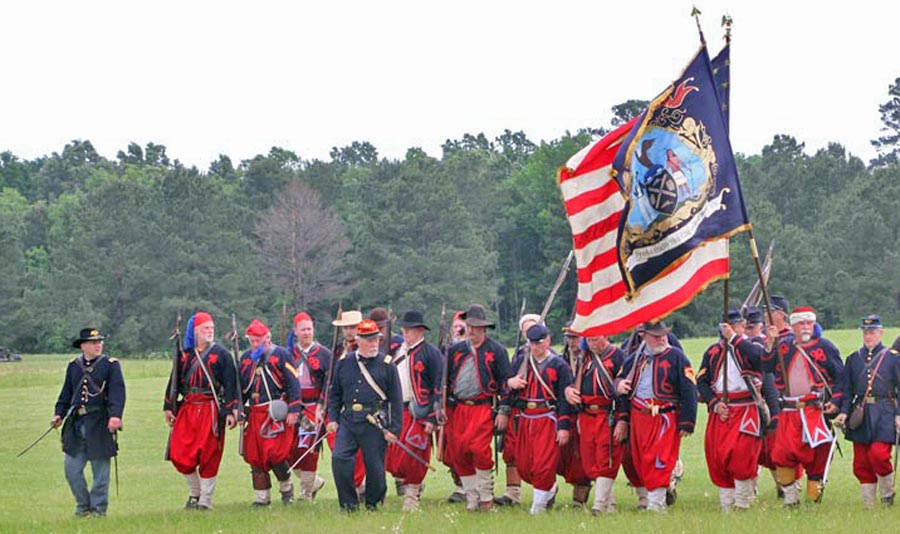 |
||||||||||||
| Yet that's not quite how it ended at the 2014 re-enactment. The Saturday crowd had seen the Mouton/Polignac and Walker charge and the Federal rout, in phase one of the battle. The Sunday crowd — a heavily Southern partisan one, as is surely to be expected in Louisiana — would hardly have been satisfied with the actual results of Chapman's Bayou/Pleasant Grove. So here, in 2014, the Southern troops chased the Yankees off the hill. Here, at the end, they lined up to take the entire field (below). | ||||||||||||
|
||||||||||||
To quote Brooksher again: "Darkness now brought a stop to the fighting. The Confederates had gained only about 400 yards against Emory at Pleasant Grove, but they were critical yards. Their advance had enabled them to gain control of Chatman Bayou, and with it control of its critical water supply so important in the 'pine desert.' The battle of Mansfield -- or Sabine Crossroads, as the Union called it -- was over. It has been a costly affair for both sides. . . . Taylor had won the battle, although Pleasant Grove was essentially a draw . . . but he had not defeated the Union expedition. He had 'stuck his neck out' in bringing on a general engagement against Kirby-Smith's desires, but his winning made that point moot." Indeed, when a courier from Gen. Kirby-Smith arrived late in the day with a letter warning against "hazarding a general engagement," Taylor told him: "Too late sir, the battle is won." A Union soldier summed up the day said "I think never felt so exhausted or so mortified at our defeat." Another wrote "This battle was a plain trap, set by the enemy, and our commander had no more gumption than to send his troops into it." Having lost control of the water at Chapman Bayou, Banks did withdraw his troops to Pleasant Hill that night. So, in truth, the Confederates did take the field — just they did so late at night. With a little PhotoShop magic, we can a bit more accurately conclude the day this way (below): |
||||||||||||
 |
||||||||||||
| Although Union Maj. Gen. A.J. Smith, the architect of the northern victory the next day at Pleasant Hill, strongly supported continuing the campaign to take Shreveport, Banks learned that his other generals — Franklin, Dwight, and most others — "absolutely opposed to the idea of advancing." Banks had not made contact with the Navy on the Red River (where water levels were getting dangerously low), nor was it likely he could get reinforcements. There were severe supply and water problems, and the time to comply with Grant's order to return A.J. Smith's troops by the first of May was getting very short. "Banks changed his mind" about advancing, and ordered a retreat (Brooksher, p. 141). The Red River Campaign was over. Mansfield had been the critical battle after all. | ||||||||||||
|
||||||||||||
Personally, we were thrilled have witnessed this impressive re-enactment; to see, hear and feel the cannon's roar; and to marvel at the period uniforms and weapons. We applaud all the organizaers and re-enactors for their outstanding performance, and the staff and volunteers from Mansfield State Historic Site for hosting this event. -- Don Roberson [comments welcome] |
||||||||||||
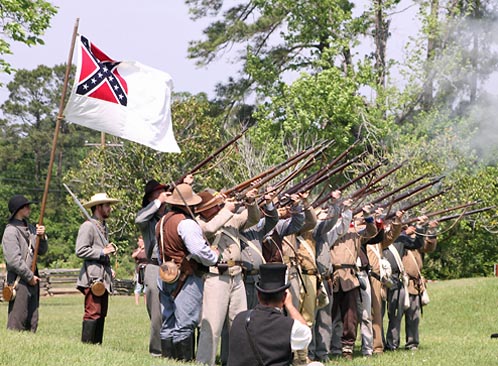


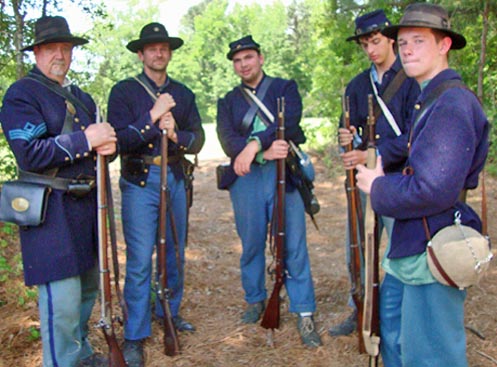
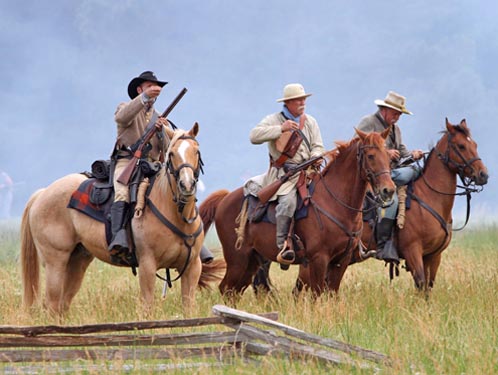
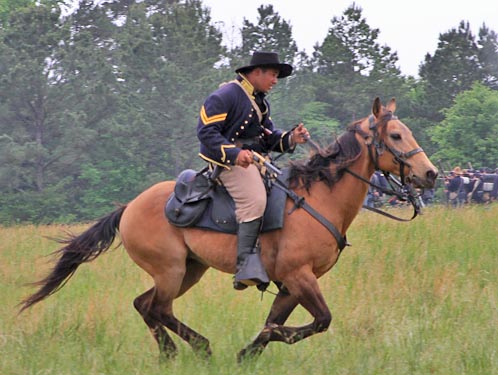
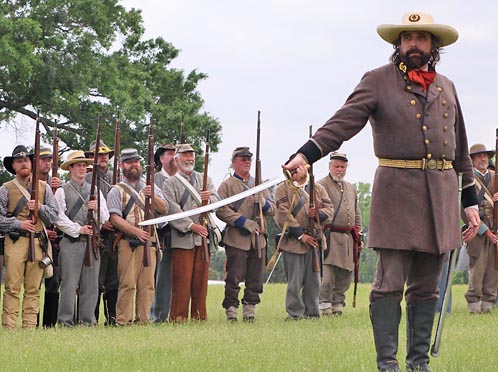
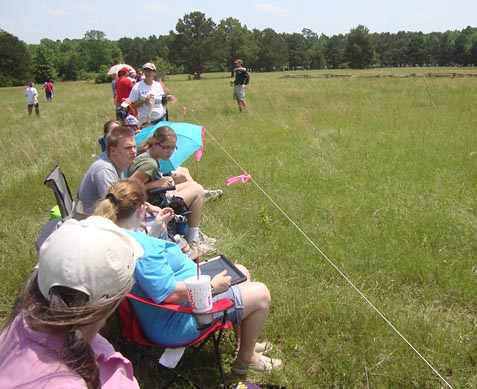 As
to the broader set of re-enactors, coordinator David Worsham advised
that: "Most re-enacting 'clubs' choose to portray a specific unit but
might attend a re-enactment recreating a battle that their particular
unit did not participate in. The clubs will then either choose to
portray a unit that fought at the battle being recreated or just
portray soldiers of the side to which they belong. The vast majority of
units fall into the latter category for the Mansfield reenactment. . .
. [However], there were groups portraying specific units engaged at
Mansfield at the reenactment as well: the Consolidated Crescent
Regiment (a Louisiana Confederate unit) recreated some of their actual
experiences during the battle. . . . The Federal Zouave unit was
portraying the 165th NY from the Federal 19th Corps."
As
to the broader set of re-enactors, coordinator David Worsham advised
that: "Most re-enacting 'clubs' choose to portray a specific unit but
might attend a re-enactment recreating a battle that their particular
unit did not participate in. The clubs will then either choose to
portray a unit that fought at the battle being recreated or just
portray soldiers of the side to which they belong. The vast majority of
units fall into the latter category for the Mansfield reenactment. . .
. [However], there were groups portraying specific units engaged at
Mansfield at the reenactment as well: the Consolidated Crescent
Regiment (a Louisiana Confederate unit) recreated some of their actual
experiences during the battle. . . . The Federal Zouave unit was
portraying the 165th NY from the Federal 19th Corps."
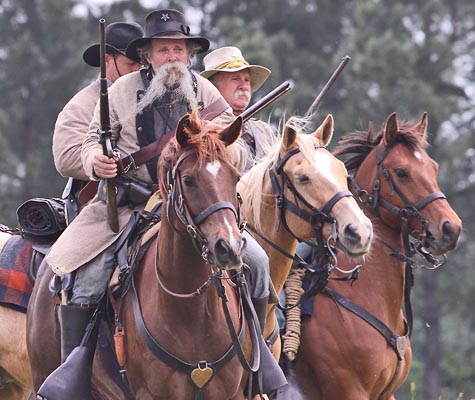
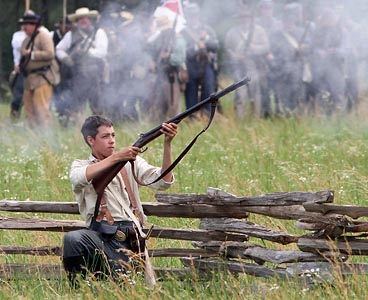



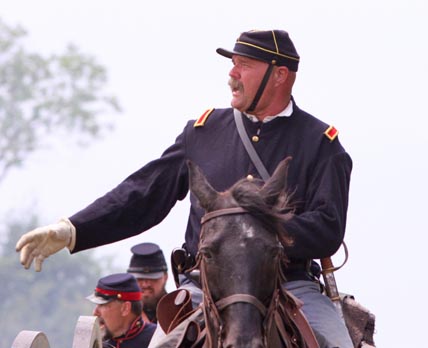 Emory
echoed his commander, urging the troops to stand fast, saying, 'Men,
you must hold this position at all hazards, before the enemy gets past
here, they must ride over me and my little gray mar.' Hold they did.
... As darkness began to fall, Emory, who sensed he had gained an
advantage, wanted to pursue it: 'I asked General Franklin, who, with
General Banks, was near me, if we could not make a demonstration with
cavalry, for I though the enemy were beaten and in full retreat. But
the cavalry could not be found -- we could not get at it -- it was
gone'."
Emory
echoed his commander, urging the troops to stand fast, saying, 'Men,
you must hold this position at all hazards, before the enemy gets past
here, they must ride over me and my little gray mar.' Hold they did.
... As darkness began to fall, Emory, who sensed he had gained an
advantage, wanted to pursue it: 'I asked General Franklin, who, with
General Banks, was near me, if we could not make a demonstration with
cavalry, for I though the enemy were beaten and in full retreat. But
the cavalry could not be found -- we could not get at it -- it was
gone'."